The combination of tiles and laminate in the hallway
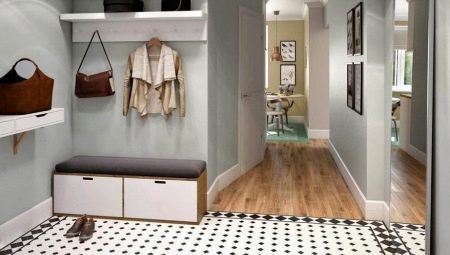
No one will pass by the hallway in the house. This means that the floor here constantly withstands mechanical stress, is exposed to moisture and dirt. It is no coincidence that people often choose sustainable materials such as tiles or laminate for finishing the floor in this part of the house, and many of them combine them, creating an interesting design.
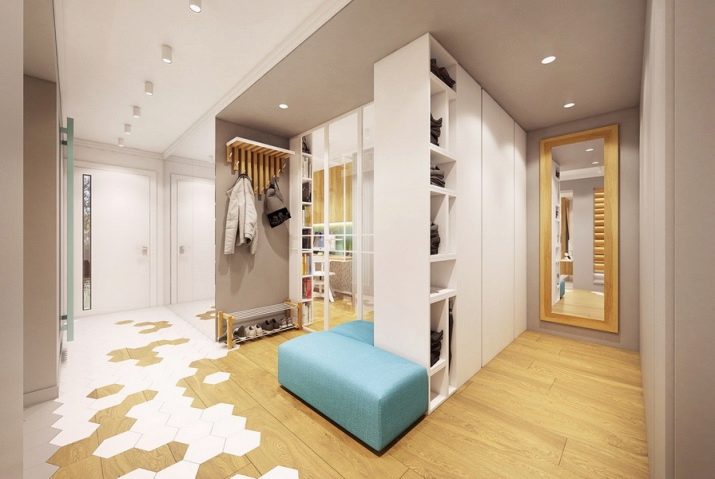
Advantages and disadvantages of combining
The combination of tile and laminate in the hallway has its advantages.
- Increases the practicality and service life of the floor, both in terms of resistance to mechanical stress and in terms of maintenance of the coating. The tiles are laid in places where the load on the floor is especially high, and the laminate serves as a kind of transition from the threshold to the rest of the hallway.
- Due to the division into 2 sections, decorated with different materials, the space in front of the entrance becomes visually larger.
- The combined floor looks original. Moreover, it is possible to arrange it in any style.
- The use of laminate and tiles, on the one hand, makes it possible to lay expensive materials, and on the other hand, the costs for them are not so high, given that you need a little of them. Sometimes it is enough to use something that was not useful during repairs at another facility, or use the remains of an unsold batch of material in a store. The price of such products is often reduced.
- Both laminate and tiles are environmentally friendly. Therefore, there is no need to worry about the well-being and health of the household.
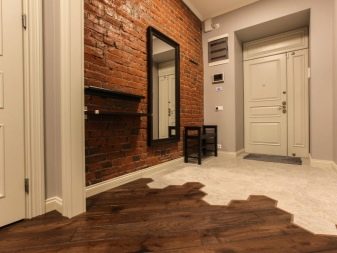
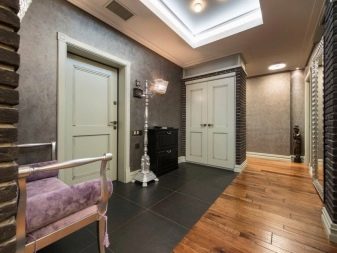
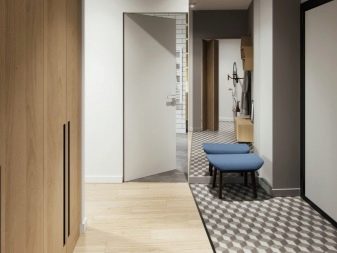

There are also disadvantages to combining.
- A reliable base is needed under the tiles. If you lay it in the hallway of a house with wooden floors, you will first need to make a screed with a reinforcing mesh. This will raise the floor level. This, in turn, will interfere with opening doors or joining tiles with other areas of the floor covering.
- The joints themselves are the least reliable place in the floor where laminate and tile are combined. As the cleaning progresses, the grout is washed away and the materials for joining break down. To prevent this place from becoming "sick" for as long as possible, you will have to take care of buying the highest quality materials and make sure that the specialists pay special attention to the accuracy of joining the two sections.
- Laminate color options are much less than tiles... In addition, you need to take into account the texture and thickness of the tile covering when collecting it for combination with laminate. If you are guided only by how both materials look from the outside, during the repair you can find unpleasant surprises that will negatively affect the result.
- Drawing up a drawing that provides for all the nuances of the arrangement of the elements of the pattern and their adjustment, taking into account the joint, takes time. In a certain situation, this is also a disadvantage. And if you do decorating "by eye", the effect can be obtained the opposite of what was intended.
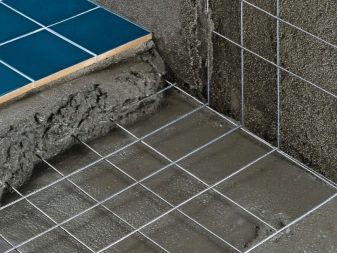
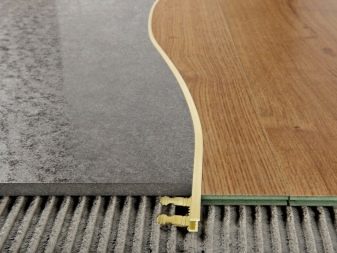
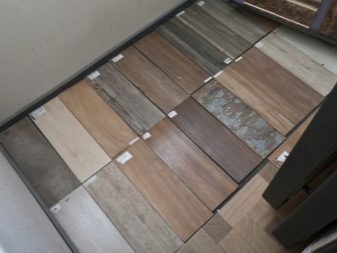

General rules
When contemplating the repair of the floor at the threshold and in the corridor, one should rely on a number of material requirements:
- they must be shock, scratch and moisture resistant;
- the outer layer must be durable;
- pollution from them - it is easy to remove, and even more so not to eat in.
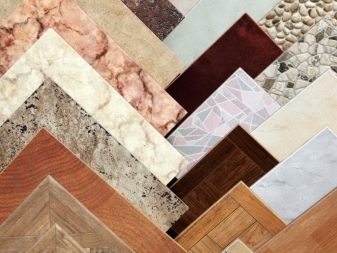

Laminate and tile are exactly the materials that meet these requirements.
Most often, you can see laminate flooring for various types of wood on sale. Although there are options for a stone, and even with patterned colors. For this material to really last a long time, especially in the hallway with its high traffic, it is better to choose instances with a class of at least 33. Under the influence of shoes at home, such a coating will last at least 15 years. The base for the laminate floor must be level.


Quality tiles also have a long service life. Considering that there are digital calculations of the wear resistance of such a material, when buying, you should focus on the 4-5 degree according to the appropriate scale of determination. At the same time, good tiles are easy to maintain.


For a coating to be safe, it must resist slipping. When choosing one or another tile, rely on the digital equivalent of 9. Material with such indicators is suitable for the site near the entrance. Even with wet shoes, there is no risk of falling on the tile floor.
Color combinations
By themselves, the colors of the tiles and laminates create a certain visual effect. If you choose white tiles, it will be combined with other finishing materials of any shade. Another question is that this choice is not very practical, since on a rough tiled surface, and this is exactly what it should be at the threshold, dirt is especially visible.
For example, gray tiles are popular in the case of corridor decoration, since they do not contradict any color of the walls... You can choose "stone" shades of gray and safely combine them with laminate of almost any shade.
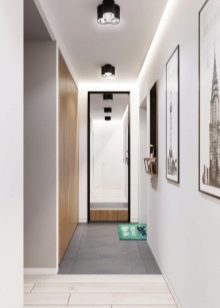
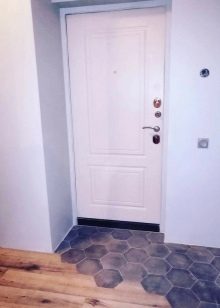
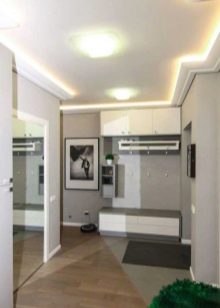
To make the connection between laminate and tile look appropriate, you can base the combination on certain approaches. For example, choose neutral tones in both tiles and laminates. When docked, their transition is imperceptible.


If you want to play with contrasts, it is better to take into account the design of vertical surfaces in the hallway, not forgetting that the device of the floor is for a long time, but the design of the walls is changed much more often. Therefore, when choosing contrasting colors, it is advisable to use traditional techniques that will later "fit" the old floor into the renovated interior.
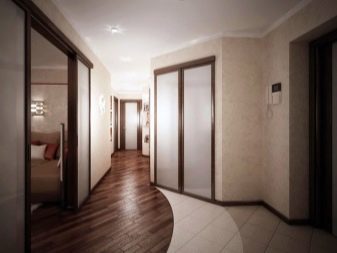

Given that the hallway is devoid of windows, you should not choose dark colors. But light colors will visually expand the space at the entrance.
The selection of tiles "under the laminate" greatly simplifies the matter. This is on sale. Outwardly, it is almost impossible to distinguish it from laminate with its traditional wood patterns, so there will be no problems when combined.
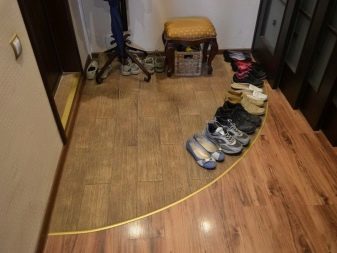
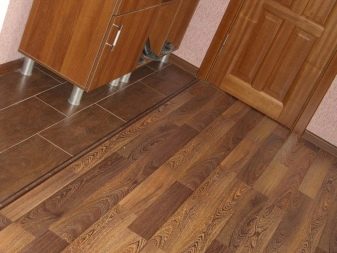
It makes no sense to accurately select the shades and textures of tiles and laminates. All the same, discrepancies in tone cannot be avoided. In addition, the complete absence of a difference will make the color scheme boring, and the difference in textures will not save. With a slight discrepancy in color, it will become almost invisible.
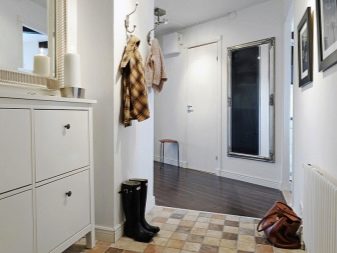

Styling options
In many ways, the result of the installation depends on what kind of tile is chosen when combining it with a laminate. It happens:
- rectangular;
- square;
- hexagonal (honeycomb);
- curly.
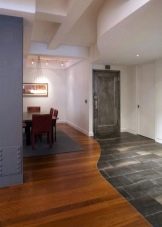
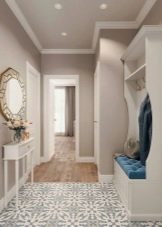
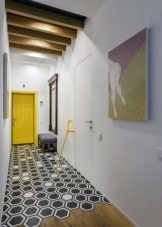
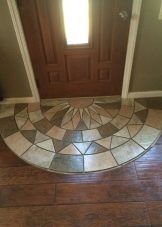
If you use tiles in the form of squares and at the same time rather large in size in a small area, this will once again emphasize the tightness. But the rectangular tiles in a narrow corridor, laid "in a striped way across" will make the room more spacious. Most of the installation options are in a spacious hallway, where you can lay out a real mosaic of multi-colored tiles, harmoniously combining it with a laminate flooring.
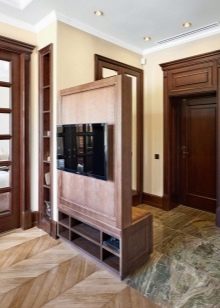

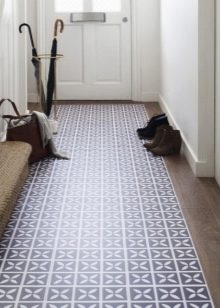
The easiest way is to lay the tiles in rows. You do not have to elaborate in the process of work, and the amount of material used is minimal.
Looks more original diagonal styling. Thanks to this, irregularities on the floor are perfectly concealed, and the corridor seems wider. However, in order to arrange the elements in this way, you need to have a good skill in such work. And it will take a lot of time to achieve the result, as well as the material, since a large number of tiles will have to be divided into parts.
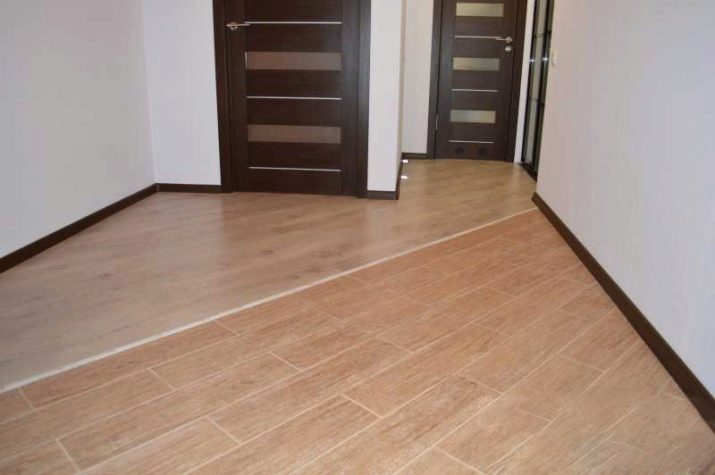
Rectangular tiles they are also laid with an offset, similar to how brickwork is created. It is interesting when the pattern on its surface imitates the appearance of natural materials.

You can lay tiles and herringbone - under parquet. For this method, narrow rectangular elements are suitable. The installation itself is not difficult. At the same time, there is almost no waste.
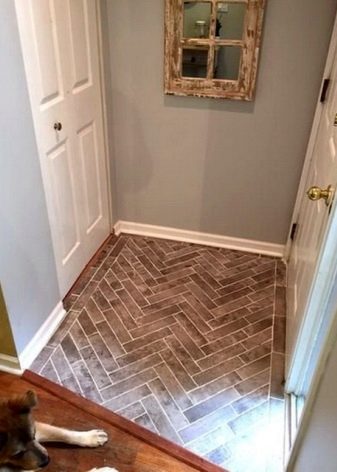

To create a transition between the tile and laminate, you need to correctly arrange the joint so that dirt and moisture do not get into it. You can use for this:
- flexible PVC profiles;
- sills made of aluminum;
- cork expansion joints;
- tinted sealant.
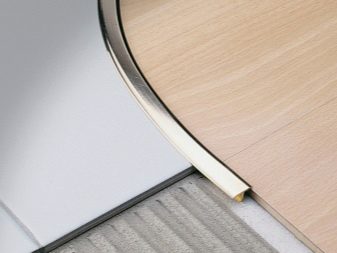
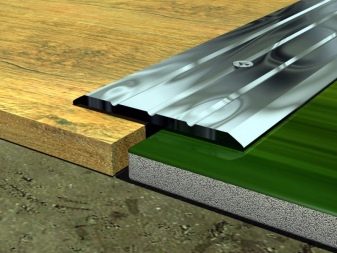
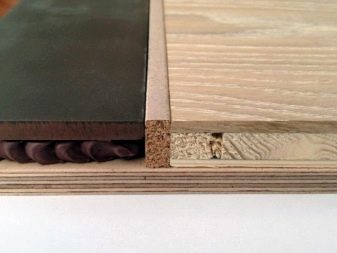
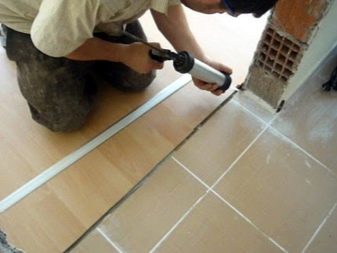
The transitions are made out with a flat strip or curved line, for example, in the form of an arc or the letter S. Sometimes the shape of the product for finishing suggests an original solution. So, honeycomb tiles can be "embedded" in the laminate area. The combination turns out to be very unusual, giving the space a kind of dynamism.
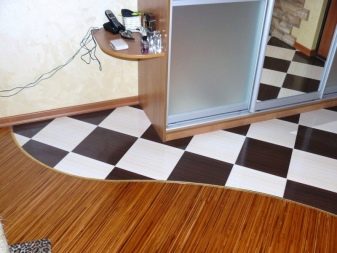
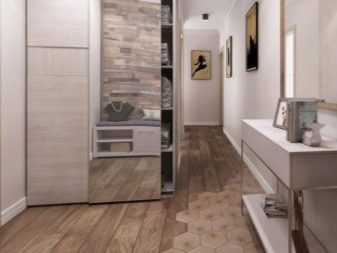
Style solutions
Modern finishing materials allow you to create a floor in any style. If you choose a wood-like tile, especially an aged one, and combine it with a laminate, it will look expensive and dignified. Classic as it is.
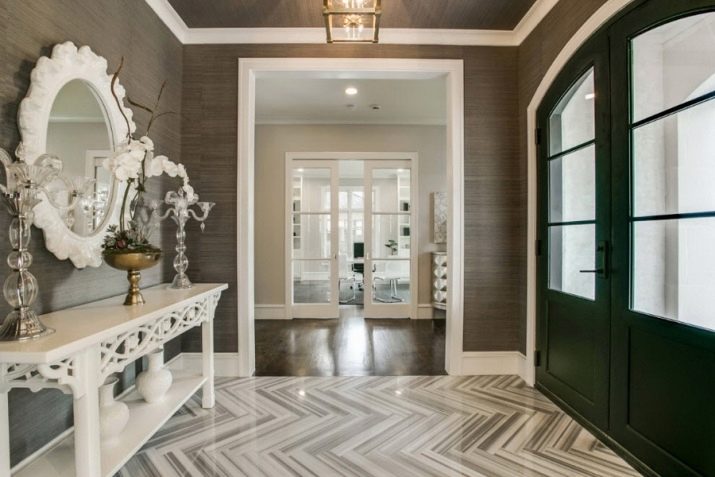
The combination of laminate with stone tiles also gives an interesting style solution. If you choose marble or granite tiles and combine with warm "wood", it looks exquisite.

An unusual design can be obtained by using patterned tiles. When laid, it creates the effect of a patchwork quilt, and in combination with laminate, it emphasizes the features of the Provence style. The hallway looks very lively when combining such materials.
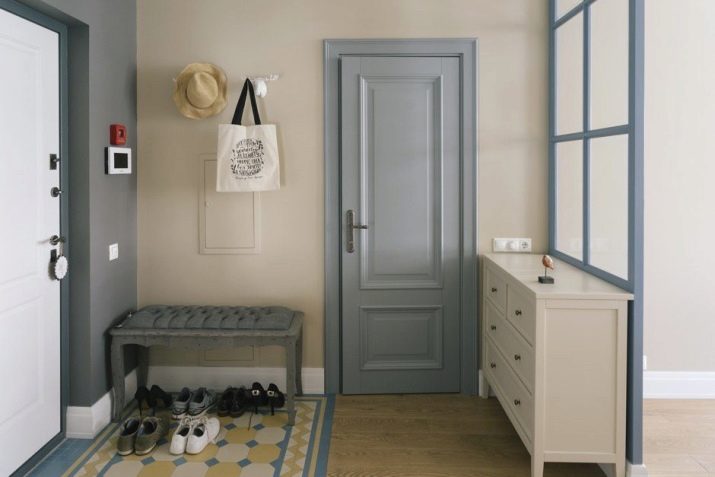
Beautiful examples
To create a stylish interior, it is not necessary to resort to particularly original techniques. The connection of the laminate part and the tiled part on the floor in the hallway can be performed in ordinary straight lines. The sophistication of this solution is added by the use of a narrow mosaic insert between one part of the floor and the other.
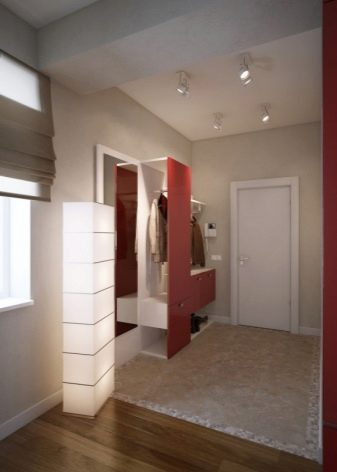

The arc joining the entrance tiles and the laminate flooring lends originality to a small hallway. The designer's sophistication does not deprive the small space at the door of its practicality. The tiles are easy to clean, but you don't have to stand for a long time on the cold tiled floor, or you can take off your shoes and quickly step over to the “warm” laminate.
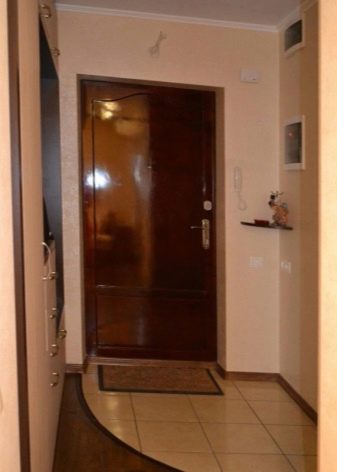
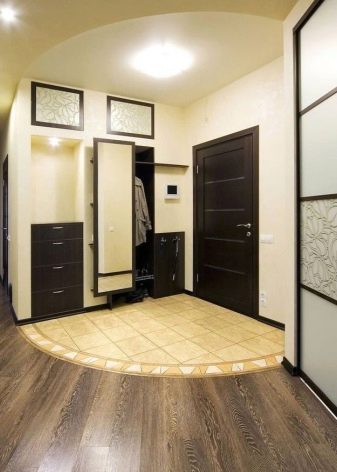
The combination of bright tiles and dark laminate is a bold decision. But in the presence of bright wall decoration, it is justified.

Combining laminate flooring with different tile patterns in the hallway leads to an interesting result. The use of patterned tiles and stone imitation allows you to create something like a bright rug in front of the doors, and the rest of the area is taken up by laminate flooring.

For information on how to make a tile and laminate joint, see the next video.








